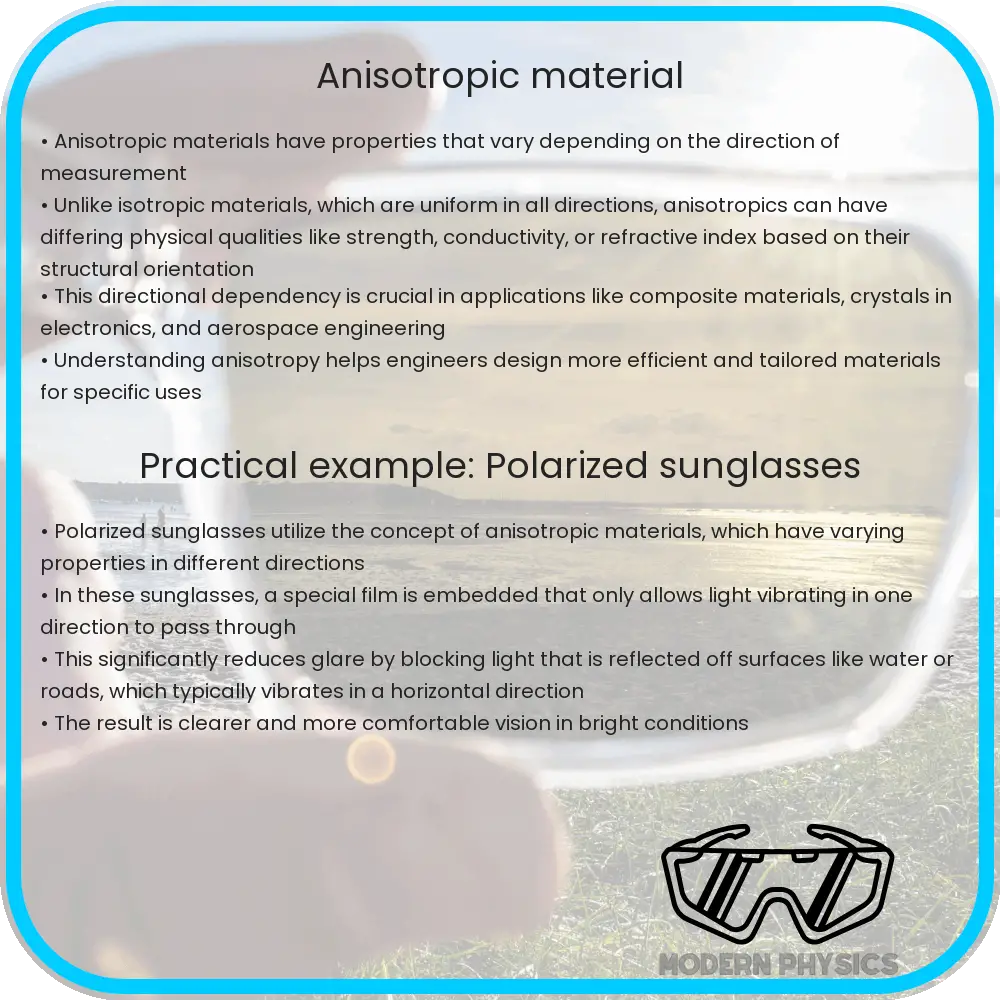Explore the fascinating world of anisotropic materials, their unique properties, applications in technology, and future prospects in our latest article.

Anisotropic Materials: Understanding Their Unique Properties and Applications
Anisotropic materials are distinct in their physical characteristics, displaying different properties in different directions. This directional dependence can be observed in various properties such as electrical conductivity, thermal conductivity, strength, and optical properties. The anisotropy of these materials is often derived from their internal structure, where the arrangement of atoms, molecules, or crystalline structures imparts unique directional properties.
Key Properties of Anisotropic Materials
The principal properties that distinguish anisotropic materials from isotropic ones include:
- Directional Strength: Anisotropic materials exhibit varying strengths depending on the direction of the applied force. For example, wood is stronger along its grain than across it.
- Thermal Conductivity: These materials conduct heat at different rates in different directions. Graphite is a classic example, with higher thermal conductivity along its planes than perpendicular to them.
- Electrical Conductivity: The electrical conductivity in anisotropic materials varies with direction, which is crucial in semiconductor technology.
- Optical Properties: The optical behavior, such as refraction, absorption, and reflection of light, can vary based on direction. This property is essential in creating polarized lenses and liquid crystal displays (LCDs).
Applications in Various Fields
Anisotropic materials find extensive applications in diverse fields:
- Electronics and Semiconductors: Their directional electrical properties are fundamental in designing microchips and semiconductor devices.
- Composite Materials: In aerospace and automotive industries, composite materials like carbon fiber reinforced plastics (CFRP) exploit anisotropy to achieve superior strength-to-weight ratios.
- Optics: Liquid crystal displays and polarized lenses benefit from the directional optical properties of anisotropic materials.
- Thermal Management: Materials like pyrolytic graphite are used in heat sinks and electronic cooling systems due to their anisotropic thermal conductivity.
Mechanics of Anisotropic Materials
The behavior of anisotropic materials under various forces and conditions is a complex topic. It involves understanding the molecular or crystalline structure and how it responds to external stimuli. For instance, the elastic modulus of a material, which measures its stiffness, can be different in various directions in anisotropic materials. This directional dependency necessitates specialized mathematical models and testing methods to accurately predict and utilize their properties in practical applications.
Furthermore, the study of anisotropic materials extends into the realm of nanotechnology and advanced material science, where engineered materials are designed with specific directional properties for targeted applications. The manipulation of anisotropy at the molecular or nano-scale opens up possibilities for innovative uses in various technological fields.
As we continue to explore and understand the unique mechanics of anisotropic materials, their potential applications expand, leading to advancements in technology and industry.
Advanced Techniques in Anisotropic Material Research
Research in anisotropic materials has evolved, utilizing sophisticated techniques to manipulate and study their properties. Techniques like molecular beam epitaxy (MBE) and chemical vapor deposition (CVD) allow for the precise control of material structure at the atomic level, enabling the creation of highly anisotropic materials. Additionally, advanced microscopy methods, including atomic force microscopy (AFM) and scanning electron microscopy (SEM), provide insights into the microstructures that contribute to anisotropy.
Future Prospects and Challenges
The future of anisotropic materials is bright, with ongoing research paving the way for groundbreaking applications. One area of significant interest is the development of anisotropic nanostructures for use in nanoelectronics and photonics. However, challenges remain in terms of manufacturing scalability and the reproducibility of properties. Moreover, as applications become more sophisticated, the need for materials with tailored anisotropic properties grows, requiring further advancements in both material science and manufacturing techniques.
Environmental and Sustainability Considerations
As the use of anisotropic materials expands, environmental and sustainability aspects become increasingly important. The production processes of some anisotropic materials can be resource-intensive and potentially harmful to the environment. Therefore, there is a growing emphasis on developing eco-friendly manufacturing processes and recycling methods to mitigate environmental impacts.
Conclusion
Anisotropic materials represent a fascinating and rapidly evolving field in material science. Their unique directional properties offer immense potential across various industries, from electronics to aerospace. As research continues to advance, the manipulation and understanding of these materials will likely lead to innovations that transform technology and industry. However, the challenges of scalable production, reproducibility of properties, and environmental considerations remain critical areas for future research and development. Embracing these challenges will enable us to fully harness the potential of anisotropic materials, leading to a new era of technological advancement and sustainable practices.
